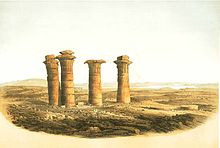Sesebi
Sesebi (also called Sese or Sudla ) is a fortified city (approx. 400 × 500 m in size) in Upper Nubia , on the west bank of the Nile between the 2nd and 3rd Nile cataracts, across from Delgo in today's Sudan .
Surname
Sesebi is the name of the place used by Egyptologists , the etymology of which is uncertain, but perhaps goes back to a misinterpretation of Sese . The closest modern village is Sese (on Mount Sese).
history
Founding additions on the local city wall show that the place was apparently expanded especially under Amenhotep IV (approx. 1340-1324 BC), before he changed his name to Akhenaten. The city walls and the temple were built under him. However, individual finds, especially ceramic shards, indicate that there was a settlement here before. The finds document a settlement up to the Ramesside period (around 1188 BC to 1069 BC), but was probably abandoned under Ramses II . Pottery is evidence of a further occupation in the Napatan period.
Details
Sesebi has a planned city map with blocks of houses laid out in a checkerboard pattern. Two types of houses could be distinguished:
- small residential units with central space without sanitary facilities
- large, two-story building with sanitary facilities and a bedroom with a niche for the bed
In the north of the city there were four temples, all of which were probably built by Amenhotep IV . They were dedicated to Amun , Mut and Chons , as well as to the sun god Aton . They were completely redecorated under Seti I and Ramses II .
Necropolises were found west of the city. Most of the graves were already heavily robbed.
exploration
The temple ruins had been known for a long time. The city was excavated from 1936-1937 by HW Fairman under the Egypt Exploration Society . So far, only a preliminary report on the excavations has been published. Further follow-up examinations have been taking place since 2008.
literature
- HW Fairman: Preliminary report on the Excavations at Sesebi (Sudla) and 'Amārah West, Anglo-Egyptian Sudan, 1937-8. In: The Journal of Egyptian Archeology. 24, 1938, ISSN 0075-4234 , pp. 151-156; especially pp. 151-154.
- Karola Zibelius-Chen : Sesibi. In: Wolfgang Helck , Eberhard Otto (Hrsg.): Lexikon der Ägyptologie. Volume 5: Building a pyramid - stone vessels. Harrassowitz, Wiesbaden 1984, ISBN 3-447-02489-5 , column 888-889.
Individual evidence
- ↑ See the discussion in Fairman in: Journal of Egyptian Archeology. 24, 1938, pp. 151-152.
- ↑ Kate Spence, Pamela Rose: New fieldwork at Sesebi. In: Egyptian Archeology. 35, 2009, ISSN 0962-2837 , p. 21.
- ↑ Fairman in: Journal of Egyptian Archeology. 24, 1938, pp. 151-154.
- ↑ Kate Spence, Pamela Rose: New fieldwork at Sesebi. In: Egyptian Archeology. 35, 2009, pp. 21-24.
Web links
Coordinates: 20 ° 6 ′ 35 ″ N , 30 ° 32 ′ 35 ″ E
